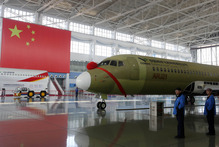- Joined
- Jul 10, 2008
- Messages
- 66,303
- Points
- 113

China's homegrown jet shows wrong way to take off
By Adam Minter
1:30 PM Friday Nov 13, 2015

After 13 years of development, and probably billions in costs, the ARJ21 remains heavier, slower, and less fuel-efficient than its competition.
China's grown tired of being a low-tech manufacturer of things that other people design. So it's throwing money and resources at an industrial upgrade.
On Tuesday, the government proudly announced one of the fruits of that effort: The country's first indigenously designed passenger jet, the 90-seat ARJ21, will be delivered to state- owned Chengdu Airlines by year's end.
There's just one problem. Of the roughly 350 additional ARJ21s on order, almost all are slated for another Chinese state-owned airline or leasing company. International airlines don't appear terribly interested.
READ MORE:
• China unveils first large passenger plane
• China unveils jetliner in bid to compete with Boeing, Airbus
It's hard to blame them. After 13 years of development, and probably billions in costs (the development costs have never been disclosed), the ARJ21 remains heavier, slower, and less fuel-efficient than its competition.
Even worse, it won't be certified by the U.S. Federal Aviation Authority, meaning it can only fly in China and the handful of South American, Asian, and African countries that recognize Chinese safety-certification standards. (Chinese state media has trumpeted the purchase of three aircraft by the Republic of the Congo.) Last fall one leading analyst concluded: "We do not consider the ARJ21 to be a viable commercial project."
That's not what China envisioned when the plane was conceived in 2002.
The ARJ21 was supposed to compete in the market for passenger jets with fewer than 100 seats -- currently dominated by Embraer and Bombardier -- and to jumpstart an aircraft manufacturing sector that would eventually challenge Boeing and Airbus. Passenger growth numbers provided incentive. Boeing expects China will need 5,580 new planes over the next two decades as it grows into the world's largest commercial aviation market.
So what's gone wrong?
First, while China's large, captive market of state-controlled airlines offers a commercial safety net, it's also dampened the incentive to innovate. Why worry about demanding foreign buyers when the government can ensure that the plane is purchased in respectable numbers at home?
China chose to base the design for the ARJ21 on the 1960s-era DC9 and reportedly has used tooling left behind in China by McDonnell Douglas in the 1990s to build it.
Second, China decided to dive straight into building a complete plane, using imported or at least foreign-designed components. That's the same approach Xiaomi used to develop a Chinese competitor to the iPhone. Indeed, Atlantic correspondent James Fallows has called the ARJ21's larger cousin, the C919, a "huge flying counterpart to the iPhone."
That might work well for products that have refresh cycles measured in months, such as smartphones. But if you're building a jet, it's a recipe for instant obsolescence. Even the newest, most innovative components can quickly become outmoded if delays occur, as they have repeatedly with the ARJ21 and its inexperienced design teams.
Most importantly, in its rush to build a jet, China chose to base the design for the ARJ21 on the 1960s-era DC9 and reportedly has used tooling left behind in China by McDonnell Douglas in the 1990s to build it. That means engineers have packed relatively new technologies into a heavy, old design, with predictably disappointing results.
China would've been better off following the path chosen by Japan, which launched its first indigenous passenger jet in 40 years, the Mitsubishi Regional Jet (MRJ), on Wednesday. Unlike the ARJ21, the Japanese plane is a high-tech, fuel-efficient marvel with more than 400 orders, the vast majority of which are international. Also unlike the ARJ21, the jet will almost certainly be certified to fly in the U.S. and most of the rest of the world.
Unlike the ARJ21, the Japanese plane is a high-tech, fuel-efficient marvel with more than 400 orders, the vast majority of which are international.
The success and credibility of the MRJ has much to do with the fact that Mitsubishi has for years been an innovative manufacturer of aircraft parts, including high-tech composite wings for the Boeing 787 Dreamliner, as well as a collaborator with top aircraft manufacturers around the world. During the height of the 787 development program, some 22,000 Japanese worked on elements of the cutting-edge plane.
These experiences gave Mitsubishi several advantages. Engineers familiar with making lightweight, fuel-efficient, composite components were quickly able to build a state-of-the- art airframe for the MRJ. Furthermore, Mitsubishi's experience working with manufacturers and regulators in other countries has smoothed the FAA certification process. Unlike China, which expects regulators to bend, Mitsubishi just opened an office in Seattle to navigate regulatory issues and provide support to North American buyers.
The MRJ's success should serve as a cautionary tale to any Chinese official who thinks bottomless funding, a will to succeed, and a large domestic market are all that's needed to create innovative products. Just as often, they result in an unproductive misallocation of Chinese resources and energy. The ARJ21 might someday be viewed as an important waypoint on China's aviation adventure. For now, it's little more than a flight delay.
By Adam Minter
Copyright ©2015, NZME. Publishing Limited


